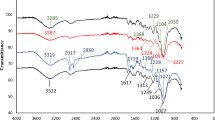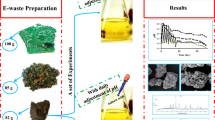Abstract
The utility of alkaline phosphatase in the precipitation of heavy metals such as Ni2+, Cd2+, Cr3+/6+, and Co2+ (from single-ion solutions as well as tannery and electroplating industrial effluents) under alkaline pH was studied with respect to bacterial alkaline phosphatase (enzyme from Escherichia coli C90) and calf intestinal alkaline phosphatase using ascorbic acid 2-phosphate, a natural substrate. Kinetic characteristics of both the enzymes at different regimes of pH 8–11 were studied to find the potential of the enzymes to remain active at certain environmental conditions. Maximum enzymatic activity was recorded at pH 9.5 and 10 for bacterial alkaline phosphatase and calf intestinal alkaline phosphatase, respectively. The precipitation of metal ions from single-ion solutions by bacterial alkaline phosphatase and calf intestinal alkaline phosphatase occurred in the order: Cd2+ > Ni2+ > Co2+ > Cr3+ > Cr6+ and Co2+ > Cd2+ > Ni2+ > Cr6+ > Cr3+, respectively. The percentage of precipitation of Cr6+ from tannery effluent (initial concentration 560 ppm) by bacterial alkaline phosphatase was found to be 15.57 % at 300 min while it was 71.47 % by calf intestinal alkaline phosphatase within 120 min. Bacterial alkaline phosphatase was found to be more efficient than calf intestinal alkaline phosphatase in removing Cd2+ from electroplating effluents from an initial concentration of 734 ppm, and the percentage of precipitation by the enzymes was 94.6 and 66 %, respectively. This work demonstrates a promising eco-friendly approach for a sustainable environment, as ascorbic acid 2-phosphate is a naturally occurring and biodegradable substrate.








Similar content being viewed by others
References
Ahuja SK, Ferreira GM, Moreira AR (2004) Utilization of enzymes for environmental applications. Crit Rev Biotechnol 24:125–154
Alcalde M, Ferrer M, Plou FJ, Ballesteros A (2006) Environmental biocatalysis: from remediation with enzymes to novel green processes. Trends Biotechnol 24:281–287
Bai H-J, Zhang Z-M, Yang G-E, Li B-Z (2008) Bioremediation of cadmium by growing Rhodobacter sphaeroides: kinetic characteristic and mechanism studies. Bioresour Technol 99:7716–7722
Baker KH, Herson DS (1994) Microbiology and biodegradation. Bioremediation, McGraw-Hill, New York, pp 9–60
Bang W, Clark DS, Keasling JD (2000) Cadmium, lead and zinc; removal by expression of the thiosulfate reductase gene from Salmonella typhimurium in Escherichia coli. Biotechnol Lett 22:1331–1335
Basnakova G, Macaskie LE (2001) Microbially-enhanced chemisorption of Ni2C ions into biologically-synthesised hydrogen uranyl phosphate (HUP) and selective recovery of concentrated Ni2C using citrate or chloride ion. Biotechnol Lett 23:67–70
Bhatnagar A, Minochaa AK, Sillanpaa M (2010) Adsorptive removal of cobalt from aqueous solution by utilizing lemon peel as biosorbent. Biochem Eng J 48:181–186
Central Pollution Control Board, Ministry of Environment and Forests (Govt. of India) (1986) The Environment Protection Rules
Chaudhuri G, Chatterjee S, Venu-Babu P, Ramasamy K, Thilagaraj WR (2013a) Kinetic behaviour of calf intestinal alkaline phosphatase with pNPP. Indian J Biochem Biophys 50:64–71
Chaudhuri G, Shah GA, Dey P, Ganesh S, Venu-Babu P, Thilagaraj WR (2013b) Enzymatically mediated bioprecipitation of heavy metals from industrial wastes and single-ion solutions by mammalian alkaline phosphatase. J Environ Sci Health A Tox Hazard Subst Environ Eng 48:79–85
Chaudhuri G, Dey P, Dalal D, Venu-Babu P, Thilagaraj WR (2013c) A novel approach to precipitation of heavy metals from industrial effluents and single-ion solutions using bacterial alkaline phosphatase. Water Air Soil Pollut 224:1–11
Coleman JE (1992) Structure and mechanism of alkaline phosphatase. Annu Rev Biophys Biomol Struct 21:441–483
Dave RS, Dave GB, Mishra VP (2011) Removal of nickel from eletroplating waste water by weakly basic chelating anion exchange resins: DOWEX 50x4, DOWEX 50x2 AND DOWEX M-4195. J Appl Sci Environ Sanit 6:39–44
Edwin Vasu A (2008) Adsorption of Ni(II), Cu(II) and Fe(III) from aqueous solutions using activated carbon. Electron J Chem 5:1–9
Gianfreda L, Rao MA (2004) Potential of extra cellular enzymes in remediation: a review. Enzyme Microb Technol 35:339–354
Hewitt EJ, Dickes GJ (1961) Spectrophotometric measurements on ascorbic acid and their use for the estimation of ascorbic acid and dehydroascorbic acid in plant tissues. Biochem J 78:384
Hidayah WR, Mangkoedihardjo S (2010) Rice husk for bioremediation of chromium (VI) polluted soil. Int J Acad Res 2:35–38
Hoylaerts MF, Manes T, Millan JL (1997) Mammalian alkaline phosphatases are allosteric enzymes. J Biol Chem 272:22781–22787
Irving H, Williams RJP (1953) The stability of transition-metal complexes. J Chem Soc 3192–3210
Krishnaswamy R, Wilson DB (2000) Construction and characterization of an Escherichia coli strain genetically engineered for Ni(II) bioaccumulation. Appl Environ Microbiol 66:5383–5386
Memon JR, Memon SQ, Bhanger MI, Khuhawar MY (2008) Banana peel: a green and economical sorbent for Cr(III) removal. Pak J Anal Environ Chem 9:20–25
Memon JR, Memon SQ, Bhanger MI, El-Turki A, Hallam KR, Allen GC (2009) Banana peel: a green and economical sorbent for the selective removal of Cr(VI) from industrial waste water. Colloids Surf B 70:232–237
Millan JL (2006) Alkaline phosphatases structure, substrate specificity and functional relatedness to other members of a large super family of enzymes. Purinergic Signal 2:335–341
Murphy JE, Kantrowttz ER (1994) Why are mammalian alkaline phosphatases much more active than bacterial alkaline phosphatases? Mol Microbiol 12:351–357
Nagata T, Kimura T, Pan-Hou H (2008) Engineering expression of polyphosphate confers cadmium resistance in tobacco. J Toxicol Sci 33:371–773
Pagnanelli F, Viggi CC, Toro L (2010) Isolation and quantification of cadmium removal mechanisms in batch reactors inoculated by sulphate reducing bacteria: biosorption versus bioprecipitation. Bioresour Technol 101:2981–2987
Pumpel T, Macaskie LE, Finlay JA, Diels L, Tsezos M (2003) Nickel removal from nickel plating waste water using a biologically active moving-bed sand filter. Biometals 16:567–581
Rengaraj S, Moon S-H (2002) Kinetics of adsorption of Co (II) removal from water and waste water by ion exchange resins. Water Res 36:1783–1793
Ruggaber TP, Talley JW (2006) Enhancing bioremediation with enzymatic processes: a review. Pract Period Hazard Toxic Radioact Waste Manag 10:73–85
Satyawali Y, Schols E, Roy SV, Dejonghe W, Diels L, Vanbroekhoven K (2010) Stability investigations of zinc and cobalt precipitates immobilized by in situ bioprecipitation (ISBP) process. J Hazard Mater 181:217–225
Sinha S, Mukherjee SK (2009) Pseudomonas aeruginosa KUCD1, a possible candidate for cadmium bioremediation. Braz J Microbiol 40:655–662
Sone M, Kishigami S, Yoshihisa T, Ito K (1997) Roles of disulfide bonds in bacterial alkaline phosphatase. J Biol Chem 272:6174–6178
Swain B, Jeong J, Lee J-C, Lee G-H (2007) Extraction of Co (II) by supported liquid membrane and solvent extraction using Cyanex 272 as an extractant: a comparison study. J Memb Sci 288:139–148
Triantafyllou S, Christodoulou E, Eou-Syngouna P (1999) Removal of nickel and cobalt from aqueous solutions by Na-activated bentonite. Clays Clay Miner 47:567–572
Wang CL, Michels PC, Dawson SC, Kitisakkul S, Baross JA, Keasling JD, Clark DS (1997) Cadmium removal by a new strain of Pseudomonas aeruginosa in aerobic culture. Appl Environ Microbiol 63:4075–4078
Wang CL, Maratukulam PD, Lum AM, Clark DS, Keasling JD (2000) Metabolic engineering of an aerobic sulfate reduction pathway and its application to precipitation of cadmium on the cell surface. Environ Microbiol 66:4497–4502
Wang CL, Ozuna SC, Lum AM, Clark DS, Keasling JD (2001) Aerobic sulfide production and cadmium precipitation by Escherichia coli expressing the Treponema denticola cysteine desulfhydrase gene. Appl Microbiol Biotechnol 56:425–430
White C, Gadd GM (1996) Mixed sulphate-reducing bacterial cultures for bio-precipitation of toxic metals: factorial and response-surface analysis of the effects of dilution rate, sulphate and substrate concentration. Microbiology 142:2197–2205
World Health Organisation (2008) Guidelines for drinking-water quality, 3rd edn. Incorporating the first and second addenda, Geneva, p 334
Acknowledgments
The authors are grateful to SRM University (Kattankulathur, Tamil Nadu, India) for providing all facilities to carry out the research work.
Author information
Authors and Affiliations
Corresponding author
Rights and permissions
About this article
Cite this article
Chaudhuri, G., Venu-Babu, P., Dalal, D. et al. Application of alkaline phosphatase for heavy metals precipitation using ascorbic acid 2-phosphate as an effective natural substrate. Int. J. Environ. Sci. Technol. 12, 3877–3886 (2015). https://doi.org/10.1007/s13762-014-0749-y
Received:
Revised:
Accepted:
Published:
Issue Date:
DOI: https://doi.org/10.1007/s13762-014-0749-y




